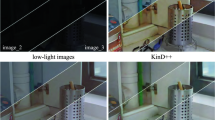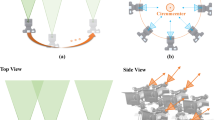Abstract
A novel ghost-free exposure fusion method for generating an HDR image of a dynamic scene is presented in this paper. Given a sequence of input images with gradually increased exposures, due to the theory that the luminance is linearly depended on the exposure time (Mertens et al. Comput Graph Forum 28(1):161–171, 2009), each input image is normalized to make it have consistent luminance with a reference image. Then moving objects in the dynamic scene are detected using a modified difference method for further exposure fusion. Experiments and comparisons show that our method has advantage in deghosting when the reference image contains saturated regions and generate high-quality results with natural textures. Furthermore, our method has a largely improved timing performance compared with previous reference-guided methods.












Similar content being viewed by others
References
Baker S, Scharstein D, Lewis J, Roth S, Black MJ, Szeliski R (2011) A database and evaluation methodology for optical flow. Int J Comput Vis 92:1–31
Gallo O, Gelfand N, Chen W, Tico M, Pulli K (2009) Artifact-free high dynamic range imaging. In: Proceedings of the IEEE International Conference of Computational Photography (ICCP). San Francisco
Gallo O, Troccoli AJ, Hu J, Pulli K, Kautz J (2015) Locally non-rigid registration for mobile hdr photography. In: CVPR Workshops
Granados M, Seidel HP, Lensch HPA (2008) Background estimation from non-time sequence images. In: Proceedings of graphics interface 2008, pp. 33–40
Granados M, Kim KI, Tompkin J, Theobalt C (2013) Automatic noise modeling for ghost-free hdr reconstruction. ACM Trans. Graph. pp. 201–201
Grosch T (2006) Fast and robust high dynamic range image generation with camera and object movement. In: Vision, Modeling and Visualization, RWTH Aachen, pp. 277–284
Hu J, Gallo O, Pulli K (2012) Exposure stacks of live scenes with hand-held cameras. In: Proceedings of the 12th European Conference on Computer Vision, ECCV'12, pp. 499–512
Hu J, Gallo O, Pulli K, Sun X (2013) Hdr deghosting: How to deal with saturation ? In: CVPR, pp. 1163–1170
Jacobs K, Loscos C, Ward G (2008) Automatic high-dynamic range image generation for dynamic scenes. IEEE Comput Graph Appl 28(2):84–93
Kalantari NK, Ramamoorthi R (2017) Deep high dynamic range imaging of dynamic scenes. ACM Transactions on Graphics (Proceedings of SIGGRAPH) 36(4):2017
Kang SB, Uyttendaele M, Winder S, Szeliski R (2003) High dynamic range video. ACM Trans Graph 22(3):319–325
Kanita KH, Telalovic J, Mantiuk R (2014) Expert evaluation of deghosting algorithms for multi-exposure high dynamic range imaging. In: Second International Conference and SME Workshop on HDR imaging (HDRi2014)
Karaduzovic K, Hasic J, Mantiuk R (2017) Assessment of multi-exposure HDR image deghosting methods. Comput Graph 63:1–17
Khan EA, Akyz AO, Reinhard E (2006) Ghost removal in high dynamic range images. In: ICIP, pp. 2005–2008. IEEE
Mertens T, Kautz J, Reeth FV (2009) Exposure fusion: a simple and practical alternative to high dynamic range photography. Comput Graph Forum 28(1):161–171
Min TH, Park RH, Chang S (2009) Histogram based ghost removal in high dynamic range images. ICME, pp. 530–533
Mitsunaga T, Nayar SK (1999) Radiometric self calibration. In: IEEE Conference on Computer Vision and Pattern Recognition, CVPR, pp. 1374–1380
Pedone M, Heikkil J (2008) Constrain propagation for ghost removal in high dynamic range images. In: VISAPP, pp. 36–41
Reinhard E, Ward G, Pattanaik S, Debevec P (2005) High Dynamic Range Imaging:Acquisition, Display, and Image-Based Lighting. Morgan Kaufmann Publishers Inc
Seetzen H, Heidrich W, Stuerzlinger W, Ward G, Whitehead L, Trentacoste M, Ghosh A, Vorozcovs A (2004) High dynamic range display systems. SIGGRAPH '04, pp.760–768. ACM
Sen P, Kalantari NK, Yaesoubi M, Darabi S, Goldman DB, Shechtman E (2012) Robust patch-based hdr reconstruction of dynamic scenes. ACM Transactions on Graphics (TOG) (Proceedings of SIGGRAPH Asia 2012) 31(6):203:1–203:11
Sidibe D, Puech W, Strauss O (2009) Ghost detection and removal in high dynamic range images. EUSIPCO
Srikantha A, Sidibe D (2012) Ghost detection and removal for high dynamic range images: recent advances. Image Commun 27(6):650–662
Tocci MD, Kiser C, Tocci N, Sen P (2011) A versatile hdr video production system. SIGGRAPH '11, pp. 1–10. ACM
Tursun OT, Akyz AO, Erdem A, Erdem E (2015) The state of the art in hdr deghosting: a survey and evaluation. Computer Graphics Forum 34(2):683–707
Tursun OT, Akyüz AO, Erdem A, Erdem E (2016) An objective deghosting quality metric for HDR images. Computer Graphics Forum 35(2):139–152
Yang W, Zhang T (1998) A new method for the detection of moving targets in complex scenes. Journal of Computer Research and Development 35(8):724–728
Zhang W, Cham WK (2012) Reference-guided exposure fusion in dynamic scenes. J Vis Comun Image Represent 23(3):467–475
Zhang W, Kuen Cham W (2010) Gradient-directed composition of multi-exposure images.In: IEEE Conference on Computer Vision and Pattern Recognition, CVPR, pp. 530–536
Zimmer H, Bruhn A, Weickert J (2011) Freehand hdr imaging of moving scenes with simultaneous resolution enhancement. Computer Graphics Forum (Proceedings of Eurographics) 30(2):405–414
Acknowledgements
This work is supported by the Project of High-level Talents Research Foundation of Jinling Institute of Technology (jit-b-201802) and the Project of Shandong Province Higher Educational Science and Technology Program under grant (No.J17 KB184).
Author information
Authors and Affiliations
Corresponding author
Rights and permissions
About this article
Cite this article
Wang, C., He, C. A novel deghosting method for exposure fusion. Multimed Tools Appl 77, 31911–31928 (2018). https://doi.org/10.1007/s11042-018-6261-5
Received:
Revised:
Accepted:
Published:
Issue Date:
DOI: https://doi.org/10.1007/s11042-018-6261-5




